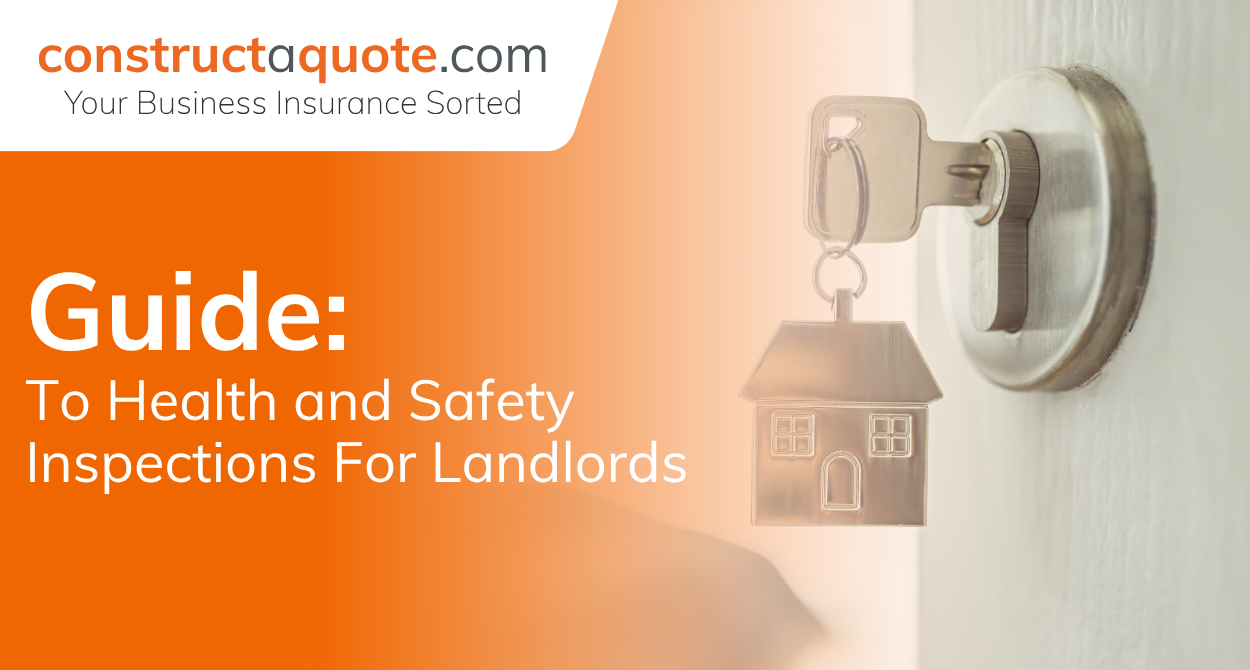by constructaquote - 20 September 2017


As a landlord, you are responsible for providing your tenant with a safe and healthy property to live in, as required by The Landlord and Tenant Act 1985.
As well as maintaining the exterior structure of the building, Landlords must ensure the property is in proper working order and supplies water, gas, and electricity.
If you’re a Landlord or considering buying a property to rent out to tenants, it’s important to familiarise yourself with the legal requirements needed to pass a health and safety inspection and this guide will highlight the key ways to do that.
Landlords’ Responsibilities
The landlord has to maintain:
Utilities
Utilities such as water, gas and electricity must have whatever is needed to ensure proper use to the tenant. That means that all the equipment required to use the utilities must be fully, safely and correctly installed. Removable equipment or appliances added by the tenant which use gas, water or electricity are not considered as “installations” as they are not provided by the Landlords’ and therefore not the Landlords responsibility.
Gas Safety
If the Landlord has installed gas appliances within the property, annual gas safety checks must be carried out by a registered Gas Fitter / Engineer. The check must be done within 12months of a new tenant taking up occupation and a copy of the gas safety check must be provided to the tenant prior to them moving in.
Electrical Safety
Landlords must ensure that the electrical installation and all electrical appliances are ‘safe’ with little risk of injury or death to humans, or risk of damage to property. The Institution of Electrical Engineers recommends a formal periodic inspection and test should be carried out at least once every ten years, or before a new tenant moves in.
If the Landlord installs electrical appliances in the property, it is his/her responsibility to ensure they are safe and fit for purpose. Any equipment supplied should be marked with the appropriate CE symbol.
Appliances supplied by the Landlord should either be brand new or checked by a qualified electrician before the property is rented to tenants and all paperwork (i.e. receipts, warranties, certificates of inspection) should be kept for a minimum period of six years.
Fire Safety
Legislation for fire safety differs based on the types of property. Some legislation affects all properties irrespective of the layout or how it is occupied and some only applies to properties that are occupied by tenants who are unrelated or only certain parts of the building.
It is the Landlords duty to follow the correct fire safety regulations for the specific property. Landlords must also:
Legionella Assessment
Landlords are legally required to perform a risk assessment for Legionnaire’s Disease. Failing to perform a risk assessment could result in a fine. The level of risk assessment required depends on the type of property and landlords should check how much is needed before carrying out extensive water sampling tests which may not be necessary.
Other Internal Facilities
As well as the high risk facilities listed above, Landlord’s should also take into consideration the following:
Ensuring tenant has access to proper wash hand basins, showers and/or baths.
Ensuring lavatories, WC basins, drains, waste pipes, rainwater goods, inlet gullies and inspection chambers are all in good working order.
Ensuring the property includes fit-for purpose sinks, draining boards, work tops, cooking facilities (or cooker points and space for cooking facilities), cupboards and/or shelves for storing cooking and eating utensils and equipment and food storage facilities.
Ensuring the property has sufficient ventilation (airbricks, trickle vents, opening lights to windows and mechanical and non-mechanical ventilation equipment.)
Ensuring the property has safety tested any kind of fitted space heating appliance(s) or central heating system.
Health and Safety Hazards
Identifying Hazards
It’s normal for faults and deficiencies to arise so it is important for Landlords to recognising these hazards in order to reduce or the risk of harm caused to an individual or damage to the property.
Landlords can identify these hazards by understanding:
The property must not contain any hazard that could lead to an increased risk to the occupant’s health, safety, and wellbeing. Therefore, Landlords must have a good understanding of the general functions of each element of the property (installations, fixtures etc) as well as the ability to identify and illuminate any hazard.
The housing health and safety rating system (HHSRS) was introduced under the Housing Act 2004 and applies to residential properties in England and Wales. It is a risk evaluation tool created to guide local authorities when identifying health and safety risks and hazards in properties with the aim to make housing safer and healthier to occupy.
HHSRS may decide to do an inspection on your property if:
The HHSRS considers a risk important when it’s effect can cause harm, making it a hazard.
An example of a hazardous risk could include a poorly maintained ceiling leading to:
An inspection must take place to identify any deficiencies and hazards in the property. Some hazards may be due to the way the property was designed or built, some may be due to normal wear and tear, and some may be due to a lack of maintenance and repair over time.
In some cases, the activities of the tenants within the property can have an affect on the potential risks and hazards. However, the HHSRS only assesses those which are the Landlords responsibility, not risks associated with any fixtures, fittings, appliances added by the tenants.
Eliminating Hazards
If the property is temporarily unfit to live in, Landlords must ask tenants to move out before major repairs take place. Landlords should agree in writing:
If you’re planning a substantial amount of major work, or want to redevelop the property, you can apply for a court order to have your tenants removed. The court is more likely to grant this if you provide alternative accommodation.
Enforcement Action
If a member of the local authority carries out an assessment on your property and determines there is a hazard, a decision is then made on the most appropriate action required to reduce or minimise a risk.
The enforcement officer will consider the level of risk associated with the hazard and potential damage it could cause to a human being or to the property. Inspectors look at 29 health and safety areas and score each hazard they find as category 1 or 2, according to its severity and level of risk.
Inspectors are encouraged to clearly communicate with the property owner and advise them on what should be done for the property to be suitable for occupants before formal action is taken.
The officer will then take the most appropriate form of action, which could be any of the following:
Landlords must take action on enforcement notices and also have the right to appeal enforcement notices. Failure to follow the enforced requirements is a criminal offence and can be punished by fines or imprisonment.
Do you have the right Landlord insurance for your property? Are you protected from potentially expensive third party claims or damage costs?
Checkout our Landlord insurance cover here…
Article sources:
www.gov.uk/government/uploads/system/uploads/attachment_data/file/9425/150940.pdf
www.pims.co.uk/health-and-safety-in-rented-property/
www.rla.org.uk/landlord/guides/legal-musts-for-landlords-and-letting-agents.shtml
www.rla.org.uk/landlord/safe-and-secure/#coldX

by Charlotte Houghton - 7 October 2020
by constructaquote - 6 October 2020
by Charlotte Houghton - 29 September 2020
by Charlotte Houghton - 24 September 2020